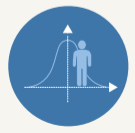The traditional system is simply not designed to produce the goals we have set for it, or that our children, communities and nation so desperately need and deserve. There are 10 primary flaws in the traditional system that perpetuate inequity and low achievement. They can be corrected by redesigning the system for success in which all students achieve mastery. These flaws of the traditional system are listed below.
Purpose and Culture
 The traditional system is focused on a narrow set of academic outcomes emphasizing academic skills, memorization and comprehension of content. It fails to recognize that student success is dependent on more than academic knowledge. Success requires a full range of foundational skills including social and emotional skills and the ability to transfer knowledge and skills to new contexts. Competency education is designed to help students learn academic knowledge, the skills to apply it and lifelong learning skills that are needed to be fully prepared for college, career and life.
The traditional system is focused on a narrow set of academic outcomes emphasizing academic skills, memorization and comprehension of content. It fails to recognize that student success is dependent on more than academic knowledge. Success requires a full range of foundational skills including social and emotional skills and the ability to transfer knowledge and skills to new contexts. Competency education is designed to help students learn academic knowledge, the skills to apply it and lifelong learning skills that are needed to be fully prepared for college, career and life.
 The traditional system is built on a fixed mindset—the notion that people’s “abilities are carved in stone.” Purpose includes ranking and sorting students creating “winners” and “losers” and perpetuating patterns of inequality in society. In contrast, a competency-based education system is built upon a growth mindset with a belief that all children can learn with the right mix of challenges and supports. Competency-based education meets students where they are to ensure that each one can be successful to the same high college- and career-ready standards.
The traditional system is built on a fixed mindset—the notion that people’s “abilities are carved in stone.” Purpose includes ranking and sorting students creating “winners” and “losers” and perpetuating patterns of inequality in society. In contrast, a competency-based education system is built upon a growth mindset with a belief that all children can learn with the right mix of challenges and supports. Competency-based education meets students where they are to ensure that each one can be successful to the same high college- and career-ready standards.
 The traditional system relies upon a bureaucratic, hierarchical system that perpetuates traditional roles, cultural norms and power dynamics. These said dynamics value compliance and doesn’t support inclusivity and cultural responsiveness. Competency education seeks to create an empowering, responsive system that is designed to build trust and challenge inequity.
The traditional system relies upon a bureaucratic, hierarchical system that perpetuates traditional roles, cultural norms and power dynamics. These said dynamics value compliance and doesn’t support inclusivity and cultural responsiveness. Competency education seeks to create an empowering, responsive system that is designed to build trust and challenge inequity.
Pedagogy
 The traditional system is organized to efficiently cover the curriculum based on age and depends on extrinsic motivation. Traditional systems developed before the emerging research about what we know about how children learn and are motivated. In competency-based education, everything should be rooted in what we know is best for students in terms of engagement, motivation and learning. Competency education fosters intrinsic motivation by activating student agency and providing multiple pathways for learning to the same high standards.
The traditional system is organized to efficiently cover the curriculum based on age and depends on extrinsic motivation. Traditional systems developed before the emerging research about what we know about how children learn and are motivated. In competency-based education, everything should be rooted in what we know is best for students in terms of engagement, motivation and learning. Competency education fosters intrinsic motivation by activating student agency and providing multiple pathways for learning to the same high standards.
 The traditional system targets supports to students when their academic or behavioral needs are identified as significantly above or below the norm (i.e., special education, gifted). Competency-based education provides timely and differentiated instruction and support. Schools offer daily flex time and time for students to receive additional support before and after the semester.
The traditional system targets supports to students when their academic or behavioral needs are identified as significantly above or below the norm (i.e., special education, gifted). Competency-based education provides timely and differentiated instruction and support. Schools offer daily flex time and time for students to receive additional support before and after the semester.
 The traditional system emphasizes assessment for summative purposes to verify what students know. One-size-fits-all assessments are conducted at predetermined points of time or at end of unit and are administered to all students at the same time and in the same format on the same content. In competency-based schools assessment for learning with robust formative assessment contribute to student growth. A balanced system of assessment aligns with high expectations that students learn how to transfer knowledge and skills through performance-based assessment. When possible, assessment is embedded in the personalized learning cycle.
The traditional system emphasizes assessment for summative purposes to verify what students know. One-size-fits-all assessments are conducted at predetermined points of time or at end of unit and are administered to all students at the same time and in the same format on the same content. In competency-based schools assessment for learning with robust formative assessment contribute to student growth. A balanced system of assessment aligns with high expectations that students learn how to transfer knowledge and skills through performance-based assessment. When possible, assessment is embedded in the personalized learning cycle.
Structure
 The traditional system allows high variability in how educators determine proficiency. Competency-based systems ensure consistency in expectations of what it means to master knowledge and skills. Districts build educator capacity to make judgments of student mastery to the same high standards.
The traditional system allows high variability in how educators determine proficiency. Competency-based systems ensure consistency in expectations of what it means to master knowledge and skills. Districts build educator capacity to make judgments of student mastery to the same high standards.
 The traditional system articulates opaque learning objectives and performance expectations with limited information for students about their learning cycle. Students receive grades with little guidance on what is needed to do better or opportunities for revision. Competency-based education values transparency with clear and explicit expectations of the learning cycle and architecture including what is to be learned, the level of performance for mastery and how students are progressing.
The traditional system articulates opaque learning objectives and performance expectations with limited information for students about their learning cycle. Students receive grades with little guidance on what is needed to do better or opportunities for revision. Competency-based education values transparency with clear and explicit expectations of the learning cycle and architecture including what is to be learned, the level of performance for mastery and how students are progressing.
 The traditional system uses academic grading practices that can often send mixed messages and misleading signals about what students know by reflecting a mix of factors, including behavior, assignment completion and getting a passing grade on tests, not student learning. Grading in competency education is designed to communicate student progress in learning academic skills and content as well as the skills they need to be lifelong learners.
The traditional system uses academic grading practices that can often send mixed messages and misleading signals about what students know by reflecting a mix of factors, including behavior, assignment completion and getting a passing grade on tests, not student learning. Grading in competency education is designed to communicate student progress in learning academic skills and content as well as the skills they need to be lifelong learners.
 The traditional system is time-based. Schools batch students by age and move them through the same content and courses at the same pace. Students advance to the next grade level after a year of schooling regardless of what they actually learned. Competency-based education is based on learning: students must demonstrate mastery of learning, with schools monitoring pace and offering additional supports to meet time-bound targets.
The traditional system is time-based. Schools batch students by age and move them through the same content and courses at the same pace. Students advance to the next grade level after a year of schooling regardless of what they actually learned. Competency-based education is based on learning: students must demonstrate mastery of learning, with schools monitoring pace and offering additional supports to meet time-bound targets.
Source: Sturgis, C. & Casey K. (2018). Quality principles for competency-based education. Vienna, VA: iNACOL. Content in this book is licensed under a Creative Commons Attribution 4.0 international license.


